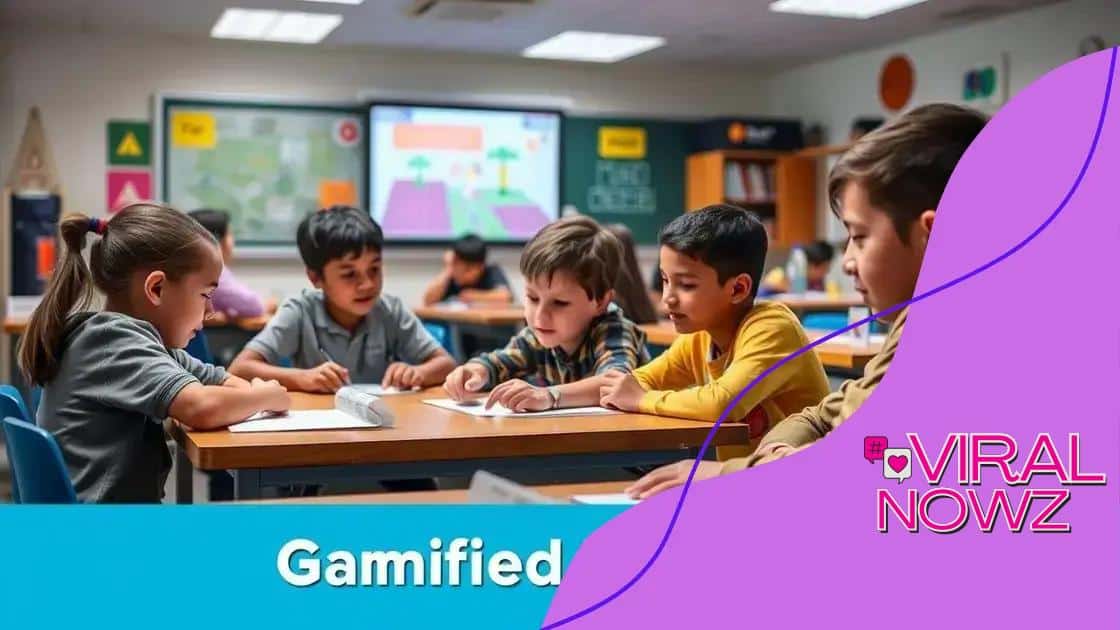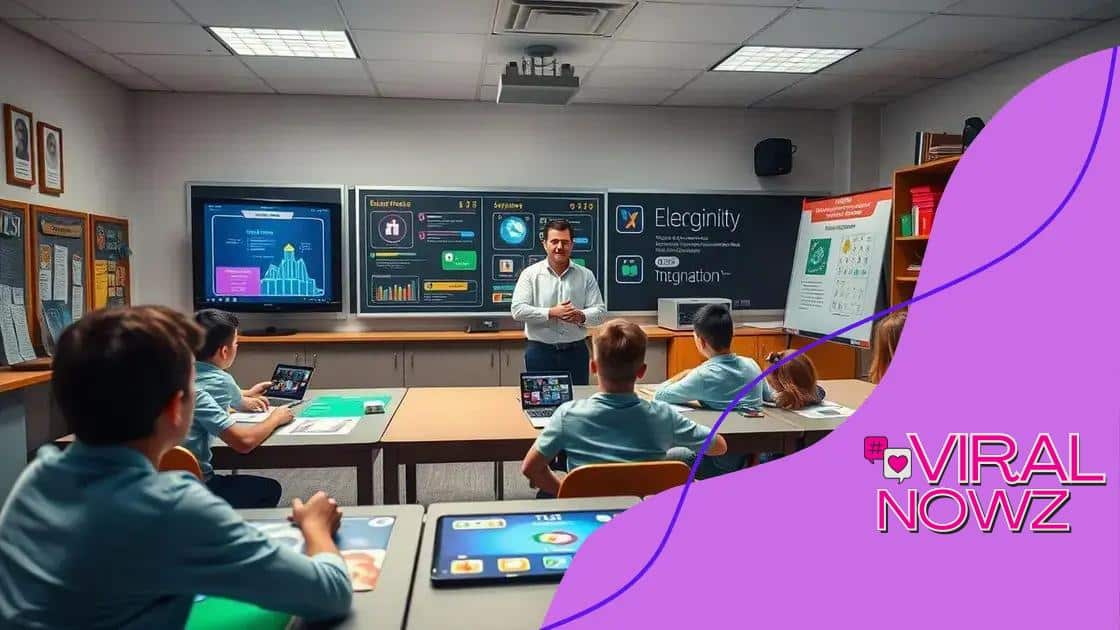Gamification for enhancing student learning outcomes

Gamification enhances student learning outcomes by increasing engagement and motivation through game-like elements such as rewards and challenges, while also addressing specific implementation challenges and measuring its impact on educational effectiveness.
Gamification for enhancing student learning outcomes is transforming educational practices. By integrating game-like elements, teachers can boost student engagement and make learning more enjoyable. Curious how this works? Let’s dive in!
Understanding gamification in education
Understanding gamification in education is essential to grasp how it can transform learning experiences. Gamification takes elements from game design and applies them to learning environments. This method enhances student engagement and motivation, making the process of learning more interactive and enjoyable.
In educational settings, gamification involves using tools like points, badges, and leaderboards. Each of these elements encourages students to participate actively. When students feel motivated by these rewards, their performance often improves.
The importance of gamification
Gamification helps develop essential skills while making lessons fun. Here are some advantages:
- Increased engagement: Students are more likely to participate when lessons are game-like.
- Motivation: Rewards can boost students to achieve their goals.
- Feedback: Instant feedback from gamified elements helps students learn faster.
- Collaboration: Games often promote teamwork and collaboration among students.
Additionally, gamification can address different learning styles and needs. By incorporating game elements, educators can reach visual, auditory, and kinesthetic learners effectively. This customization ensures that no student is left behind.
As we delve deeper into the advantages, it is evident that gamification fosters a supportive learning environment. This approach encourages students to take risks and make mistakes in a safe space, ultimately leading to richer learning experiences. When students are engaged and motivated, the overall atmosphere in the classroom improves.
Benefits of gamification for student engagement
The benefits of gamification for student engagement are numerous and impactful. By incorporating game elements into learning experiences, educators can foster a sense of enthusiasm and excitement among students. This innovative approach not only makes the learning process more enjoyable but also enhances knowledge retention.
One important benefit is that gamification increases motivation. When students are rewarded with points, badges, or levels, they are more likely to participate actively. This sense of achievement can drive students to push their limits and strive for better performance.
Enhancing Participation
Gamification creates a competitive environment where all students can engage without fear of failure. Here are key benefits:
- Improved focus: Game mechanics capture attention, which helps students stay on task.
- Increased collaboration: Group activities foster teamwork and communication skills.
- Instant feedback: Gamification allows students to see their progress in real time, making adjustments easier.
- Personalized learning: Students can progress at their own pace, catering to individual learning styles.
Another benefit is the enhancement of problem-solving skills. Gamified activities often involve challenges that require critical thinking and creativity. When students face these tasks in a fun setting, they are more inclined to experiment and explore new ideas.
Furthermore, research shows that students who experience gamified learning environments tend to have higher academic performance. This correlation suggests that when engagement increases, so does understanding and retention of the material.
Effective gamification strategies for teachers

Effective gamification strategies for teachers are key to engaging students and enhancing their learning experience. By applying game design principles in the classroom, educators can create a more dynamic and interactive environment.
One approach is to incorporate points and badges for completing tasks. This rewards students for their efforts and encourages healthy competition among peers. For instance, assigning points for participation can motivate students to engage more with the material.
Creating a Game-Like Environment
Another effective strategy is designing classroom activities that resemble games. Here are some techniques:
- Use challenges: Create specific challenges that students must complete, providing a sense of achievement.
- Set clear goals: Define clear objectives for each activity to guide students on what they need to accomplish.
- Encourage collaboration: Implement group activities that promote teamwork, allowing students to learn from each other.
- Give instant feedback: Utilize digital tools or game-like formats to provide immediate responses to students’ efforts.
In addition to these strategies, integrating stories and narratives can enhance student interest. By weaving a storyline into the learning content, teachers can capture students’ imaginations, making lessons more relatable and memorable.
Another vital aspect is to adapt gamification for different learning styles. For visual learners, using colorful graphics and interactive elements can make lessons more appealing. Kinesthetic learners benefit from hands-on activities, while auditory learners may excel with verbal instructions and discussions.
Ultimately, by employing these effective gamification strategies, teachers can create an engaging learning atmosphere. Gamification not only fosters student excitement but also enhances understanding and retention of material.
Challenges in implementing gamification
The challenges in implementing gamification in education can be significant, but understanding them can lead to more effective strategies. One major hurdle is the resistance from both students and teachers. Some educators may feel uncomfortable with new methods, while students might not initially embrace the gamified approach.
Another challenge is the resource requirement. Successful gamification often needs technology like computers or tablets, which may not be accessible to every school. This lack of resources can limit the effectiveness of these initiatives.
Balancing Games and Learning
Additionally, finding the right balance between fun and educational content is essential. Here are some concerns teachers might face:
- Overemphasis on rewards: Too much focus on points or badges can shift attention away from actual learning.
- Student engagement: Not all students respond to gamification the same way, making it challenging to engage everyone.
- Time consumption: Designing and implementing gamified lessons requires significant time and effort.
- Assessment difficulties: Measuring progress and understanding in a gamified environment can be complex.
Moreover, it’s crucial for educators to stay updated with the latest trends in gamification. This field evolves quickly, and keeping up can be daunting. Without current knowledge, teachers may struggle to implement effective gamified strategies.
Despite these challenges, the potential benefits of gamification in enhancing learning outcomes should not be overlooked. Identifying and addressing these barriers can pave the way for a successful integration of gamification into educational practices.
Measuring the impact of gamification on learning
Measuring the impact of gamification on learning is vital for understanding how effective these strategies are. To truly assess whether gamification enhances education, educators must explore various metrics.
One approach is to analyze student performance before and after gamified activities. Comparing test scores or assignment grades can reveal how much this method aids learning. Tracking engagement levels, such as attendance and participation, can also provide insights into the effectiveness of gamification.
Using Surveys and Feedback
Gathering feedback directly from students is another useful method. Implementing surveys that focus on their perceptions of the gamified experiences can shed light on their engagement and motivation levels. Here are some key aspects to consider when measuring impact:
- Student satisfaction: Students’ enjoyment and interest can influence their overall learning experience.
- Behavioral changes: Observing how students interact during activities gives clues about engagement.
- Skill mastery: Assessing how well students grasp the material is crucial for evaluating learning gains.
- Retention rates: Checking if students remember concepts learned through gamification can show lasting effects.
Another significant aspect is the time spent on task during gamified lessons. Frequent, active participation can lead to better retention of content. If students are continuously immersed in learning, the chances are higher that they will remember and apply what they’ve learned.
Lastly, educators need to analyze longer-term results. Checking progress over weeks or months can help determine if gamification has lasting benefits. This long-term measurement can reveal trends and show whether gamification continues to make a difference beyond initial excitement.
FAQ – Questions About Gamification in Education
What is gamification in education?
Gamification in education involves using game design elements to enhance learning experiences, making them more engaging and interactive.
How can gamification improve student engagement?
Gamification helps boost student engagement by providing rewards and recognition, making learning feel more like a game, which motivates students to participate.
What challenges might teachers face when implementing gamification?
Teachers may encounter challenges such as resistance to new methods, limited resources, and finding a balance between fun and educational content.
How can educators measure the impact of gamification?
Educators can measure the impact of gamification by analyzing student performance, gathering feedback, and observing engagement levels through surveys and activities.





